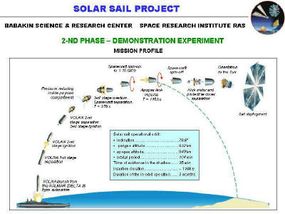Cosmos-1 Mission
Launch Vehicle
To get Cosmos-1 into Earth orbit, the spacecraft will be loaded into a modified intercontinental ballistic missile (ICBM) of Russian design, called the Volna. The ICBM will be launched from a Russian submarine in the Barents Sea. Typically, the Volna ICBM does not have enough thrust to reach orbit, but the missile used for Cosmos-1 will have an added rocket engine (kick stage) that is used to de-orbit satellites. The kick-stage engine will provide the additional thrust required to get Cosmos-1 into orbit.
Once in orbit, the solar sails will be deployed. The mission could last anywhere from a few days to a few months. The mission will be deemed a success if the spacecraft can move to a higher orbit using the solar sails. If the goal of the mission is achieved, and if the mission lasts longer than a few days, there may be an additional test to determine if Earth-based lasers can supply sufficient light to push the spacecraft in orbit.
Advertisement

Other Solar Sail Missions
Groups other than The Planetary Society have proposed and are developing solar-sail missions. In August of 2004, two large solar sails were launched and deployed into space by the Japanese Aerospace Exploration Agency. NASA is developing a solar-sail spacecraft for launch. The German Space Agency (DLR) and European Space Agency (ESA) also have a solar-sail spacecraft in development, and Carnegie Mellon University is working on a heliogyro solar sail.
